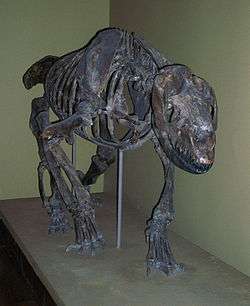Homalodotherium
| Homalodotherium Temporal range: Early to middle Miocene | |
|---|---|
 | |
| Mounted skeleton of Homalodotherium cunninghanni in the Field Museum of Natural History, Chicago | |
| Scientific classification | |
| Kingdom: | Animalia |
| Phylum: | Chordata |
| Class: | Mammalia |
| Order: | †Notoungulata |
| Suborder: | †Toxodonta |
| Family: | †Homalodotheriidae |
| Genus: | †Homalodotherium Huxley, 1870 |
Homalodotherium is an extinct genus of the order Notoungulata, an extinct group of hoofed mammals native to South America.

Homalodotherium was about 2 metres (6.6 ft) in body length, with a weight up to 300 kg, and had long forelimbs with claws instead of hooves. It walked on the soles of its hind feet and the toes of its front feet, which would have made the animal higher at the shoulder than at the hips when it walked on all fours. It was probably at least partially bipedal, being able to pull down tree branches with its arms while rearing up on its hind legs.[1] Various other prehistoric and living creatures have also developed this feeding style; examples are the chalicotheres, ground sloths (which shared the same environments), the giant panda and, possibly, the therizinosaur dinosaurs.